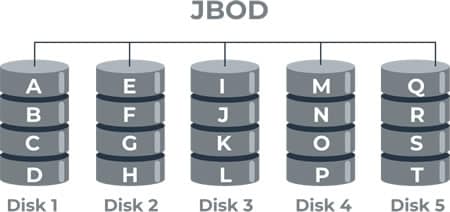JBOD Data Recovery
JBOD Data Recovery – JBOD, short for “Just a Bunch of Disks,” is a storage configuration that combines multiple hard drives into a single logical unit, but without the redundancy or fault tolerance offered by RAID (Redundant Array of Independent Disks) arrays. While JBOD setups provide increased storage capacity, they lack the data protection mechanisms found in RAID arrays, making them susceptible to data loss in the event of disk failure or other unforeseen circumstances.
Data recovery from JBOD arrays can be a challenging task, as the process depends on various factors, including the number of failed disks, the type of file system used, and the complexity of the data layout. However, with the right tools and expertise, it is often possible to retrieve lost or inaccessible data from JBOD configurations.

Understanding JBOD Data Storage
In a JBOD array, data is written sequentially across the available disks, without any form of parity or mirroring. This means that if one disk fails, the entire array becomes inaccessible, and data spanning across multiple disks may be lost or corrupted. Unlike RAID arrays, JBOD offers no built-in redundancy or fault tolerance, making data recovery more complicated.
Common Causes of Data Loss in JBOD Arrays
Some of the most common causes of data loss in JBOD arrays include:
- Disk failure: Hard drives are mechanical devices and are prone to failure over time. If one or more disks in a JBOD array fail, the entire array may become inaccessible, leading to data loss.
- Accidental deletion or formatting: Inadvertently deleting or formatting the JBOD array can result in permanent data loss if no backups are available.
- Power surges or system crashes: Unexpected power outages or system crashes can corrupt data or file system structures, making it difficult to access the data on the JBOD array.
- Logical errors or file system corruption: Software bugs, viruses, or other logical errors can lead to file system corruption, rendering the data on the JBOD array inaccessible.
JBOD Data Recovery Process
The process of recovering data from a JBOD array typically involves the following steps:
- Disk imaging: The first step is to create a byte-by-byte copy (image) of the affected disks in the JBOD array. This ensures that the original data remains untouched during the recovery process, minimizing the risk of further data loss or corruption.
- Disk analysis: Once the disk images are created, data recovery professionals use specialized tools to analyze the disk structures, file systems, and data layouts. This analysis helps determine the extent of data loss and the best approach for recovery.
- File system reconstruction: Depending on the file system used (e.g., NTFS, ext4, HFS+), data recovery software can attempt to reconstruct the file system structure and locate the lost or inaccessible data.
- Data extraction: After locating the lost or inaccessible data, the recovery software can extract and salvage the files from the disk images, allowing for data retrieval.
- Data verification: Finally, the recovered data is verified for integrity and completeness to ensure that the recovery process was successful.
Professional Data Recovery Services
While it is possible to attempt JBOD data recovery using specialized software tools, the process can be complex and time-consuming, especially for large or heavily fragmented data sets. In such cases, it is recommended to seek the assistance of professional data recovery services.
Professional server data recovery experts have the necessary tools, expertise, and experience to handle even the most challenging JBOD data recovery scenarios. They employ advanced techniques, such as file carving, sector-by-sector scanning, and specialized algorithms, to maximize the chances of successful data recovery.
Learn more about data recovery on Servers
JBOD arrays offer increased storage capacity but lack the data protection mechanisms found in RAID configurations. As a result, data loss can occur due to disk failures, accidental deletions, or other unforeseen circumstances. While JBOD data recovery is possible, it can be a complex process that often requires professional assistance, especially in cases involving large or heavily fragmented data sets. By understanding the risks associated with JBOD arrays and implementing proper data backup strategies, users can minimize the potential for data loss and the need for costly data recovery services.

